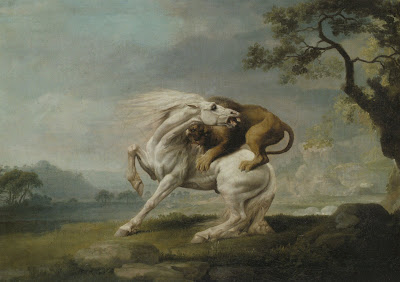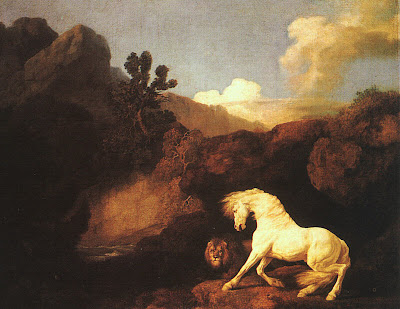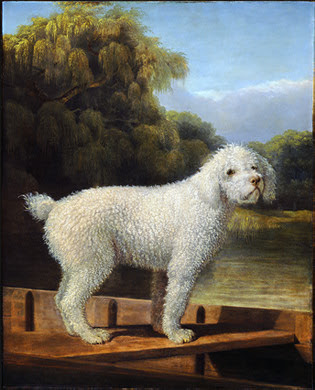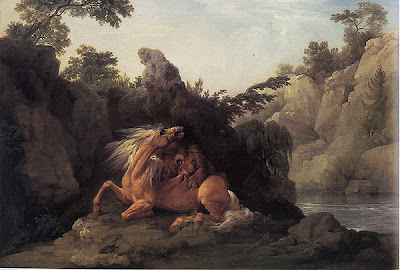Radio National’s arts program Art Works recently asked The Art Life to contribute to their series of essays on paintings that have had an influence on writers. We didn’t have to think for very long to know exactly which painting we wanted to write about. Here is an expanded version of the piece which will go to air in the very near future:
George Stubbs A Lion Attacking A Horse was painted sometime around 1765. The title describes exactly what’s happening in the picture – a white stallion is being torn apart by a ferocious lion. The action takes place in a starkly theatrical landscape of willowy, wind swept trees and distant hazy mountains. The horse is majestic but doomed, the lion, a ravaging monster. It’s Claude Lorraine meets Lord of The Rings. The painting is in the collection of the National Gallery of Victoria and that’s where we first encountered it in the early 1980s.

George Stubbs, A lion attacking a horse, c. 1765.
Oil on canvas, 60×100 cms.
Collection of the National Gallery of Victoria.
A Lion Attacking A Horse isn’t a masterpiece and it’s not the greatest Stubbs. The famed equestrian artist – who lived between 1724 and 1806 – painted this scene 17 times over the course of three decades while working on his bread and butter jobs of painting his patron’s horses, dogs and families. These somewhat atypical paintings were an attempt by Stubbs to tackle a serious subject – and to be taken seriously by the English art world of the Enlightenment. A Lion Attacking A Horse was intended as an elaborate metaphor of the sublime – an artful deployment of 18th century special effects. Upon looking at this scene the viewer was supposed to experience feelings of dread, apprehension and fear – and from this a further sensation of guilty pleasure – rather like watching the Titanic sink on the cinema screen, the audience experiencing a weird mixture of horror and sick fascination. As the catalogue for the exhibition Stubbs – A Celebration explained:
“Edmund Burke’s popular concept of the Sublime [was that] the thrill engendered by violent subjects […] were awesome in their terrible beauty. When it showed terror, the horse — powerful, beautiful, and noble as man himself — exempli?ed the Sublime. The horse’s shock at encountering the lion re?ected the viewer’s own. […] In Stubbs’s time, the horse was regarded as a noble creature, closest to man in physical perfection and sensibility. The lion symbolized the primeval forces of unbound, often brutal nature. Stubbs’s series unusually presents a moral theme: it is the struggle, not the inevitable defeat that matters. Because he fights to the end, the noble, unyielding horse ultimately prevails.”
Meaning in an artwork isn’t fixed –it changes over time as one idea or concept drops out of fashion as another takes over. For us, when we first saw it, A Lion Attacking A Horse, was a fantasy picture, a literal Surrealist nightmare. Now we look at it as a picture with a wealth of hidden meanings and metaphors. It was created partly in the tradition of Enlightenment painting, looking to classical subjects for inspiration and moral guidance, yet it has strong Romantic overtones. Stubbs is said to have been inspired by an ancient pre-Hellenistic sculpture he had seen on a visit to Rome. But some art historians have suggested his picture is more likely the result of something he had seen in reproduction. In that regard, A Lion Attacking A Horse is a precursor of modern painting, an idea or concept given form without regard to reality, even if – by coincidence – the landscapes in his horse and lion paintings comes from a real place called Creswell Crag in Nottinghamshire. Stubbs mixed Romanticism and Neo Classicism together to come up with his signature image, a hybrid picture that doesn’t fully belong to any single tradition but instead betrays the peculiar imagination of an artist who wanted to be part of the bigger picture of concept and fashion.

George Stubbs, A Horse Frightened by a Lion, 1770.
Oil on canvas.
Collection: Walker Art Gallery.
National Museums Liverpool
Stubbs was an artist with whom many contemporary artists working today could identify. His work was unfashionable because although he was recognised as a master craftsman, his work didn’t properly conform to the Royal Academy’s hierarchy of genres – which was basically history painting at the top, pictures of animals and nature at the bottom. If you were to prove yourself as an academy artist, then you would need to not only paint in a particular style to demonstrate you had the skills, you would also need to include a set of prescribed visual cues such as a suitable historical subject chosen to metaphorically illustrate a contemporary event, and you would need to populate your paintings with people, not animals. Stubbs and his horses just didn’t rate.
The artist had made a number of career gaffs too. Stubbs didn’t live in London because his patron’s were out in the country so he was far from the action of the art world. He didn’t belong to the Royal Academy because although he had been technically accepted as a member, he just couldn’t bring himself to send in an example of his work for final approval. Instead, he chose to remain a member of the Society of Artists which was more like a trades union than a club for art world aristocracy. Stubbs was unfashionable in both art and attitude, and seems more like a loveable maverick more interested in doing things his way than the goofy country bumpkin he’s so often portrayed as having been. For artists working today who find themselves outside the fashionable art world, the parallels between Stubbs’s time and now are remarkable.

George Stubbs, White Poodle in a Punt, c. 1780.
Paul Mellon Collection
Stubbs has proven enduringly popular with the punters. Although he couldn’t break out of his commercial success – his career did offer him the dividends of loyal and generous patrons – he struggled to create much besides his equestrian art and his lions and horses. Although Stubbs made forays into quasi-Romantic subjects it’s interesting to note how his work and life were interpreted in the time after his death. He died without having had a biography written during his life time so much of his life’s detail was a speculative feast for future writers. The counter Romantic sentiment of the 19th Century cast Stubbs as a “real man” [read – not gay, not a fop] who not only painted horses, but he was a man who could carry a horse carcass on his back up three flights of stairs to his studio to draw it in various stages of dissection. His work was thought to have had a sort of utilitarian realism that eschewed frippery and metaphor. A horse was a horse in a Stubbs painting, or in the case of his paintings of pets, a dog was a dog. One biographer valorizing Stubbs’s ability to ‘realistically’ portray an animal without recourse to metaphor remarked “[Stubbs] never found an immortal soul in a poodle’s eye.” Oh dear, good dogs don’t get into heaven.

George Stubbs, Horse Attacked by a Lion. 1763
Oil on canvas.
Collection of Tate, London.
Postcards of the NGV’s version of A Lion Attacking A Horse have been on offer since it was purchased in 1949 and takes pride of place in the racks of the newly renovated NGV bookshop. Stubbs’s work still reaches out to people who like their art accessible and figurative. And this was more or less the way the painting was thought of when it was bought. The NGV had, in the late 19th and 20th century, gone on a purchasing program aimed at buying as many masterpieces as they could get their hands on. Thus works by Tintoretto, Van Dyck, Tiepolo, Reynolds, Gainsborough, Turner, Constable, Monet, Pissarro and Modigliani would up in Melbourne [along with the fake Rembrandt… oops.] The Felton Bequest – named for the rich Melbourne pharmaceutical dealer and art gallery benefactor Alfred Felton – used agents in Europe to spot works as they came up for sale. Working for the NGV in the late 1940 was none other than Lord Sir Kenneth Clarke who wrote to the then director of the NGV Daryl Lindsay saying that he had a purchase to recommend. “Pursuing our policy of buying minor English pictures,” Clarke wrote, “I have persuaded A.J. L. McDonell to buy the Stubbs…There is rather too much space round the central group, but the group itself is marvellous, and had a great influence on the Romantic Movement; Gericault actually did a copy of it. I think it was cheap at 500 pounds, and personally would rather have it than a second rate Braque at 2,000 pounds.”
We were raised as devout Modernists, but A Lion Attacking A Horse has been for us a window through which we could discover the vast landscapes of pre-20th century art. When we tell people we love Stubbs they think we’re insane – isn’t he the guy who just painted horses? Sure, he was, but A Lion Attacking A Horse is a work of art whose metaphors are just as relevant now as they were in 1765. The metaphor of civilisation being destroyed by nature is about as topical as it gets. Oh – and one last thing: masterpieces are boring. Their meaning is circumscribed, your enjoyment of them overly determined by others. Non-canonical art works – modest works like A Lion Attacking A Horse – offer another history of art that’s waiting to be discovered. Forget Picasso, forget Rembrandt – go Stubbs.
